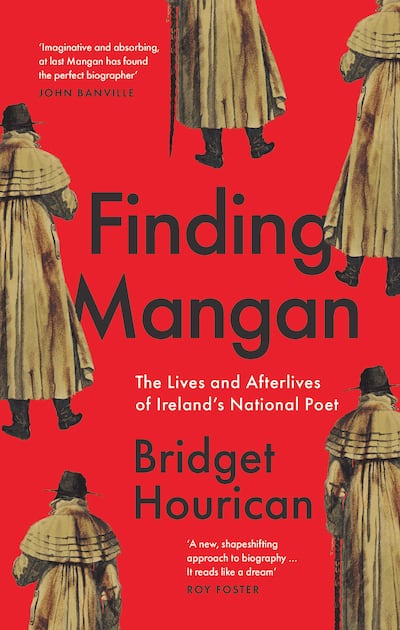I was introduced to James Clarence Mangan by Shane MacGowan at 3am in a lock-in in the Liberties in a brilliant if sadly short-lived bar called McGruders. I knew nothing at all about Mangan except as a name in the morass of Irish poets before Yeats, but I was entranced by the poem Shane showed me, A Vision of Connaught in the 13th Century, and by the sense I was picking up of Mangan as a kind of precursor to Shane: the artist as bohemian and outsider – what the French Romantics called a poète maudit.
When I started to read up on him, I discovered that’s exactly who he was in life – his peers would fixate morbidly on his “insane orgies… transacted in the lowest and obscurest taverns, and in company with the offal of the human species” to quote (a hyperbolic) John Mitchel – but after his death in 1849, aged just 46, he was canonised as the “national poet”, revered for his Famine poems, and placed on the school syllabus for much of the 20th century, with his most famous poem, My Dark Rosaleen, sung by Count John McCormack. He was even put on a stamp.

Of course, hellraisers can become national treasures – MacGowan is a case in point – but what amazed me is that Mangan found his way back to the margins: once he was dropped from the syllabus in the early 1970s, he didn’t disappear into the footnotes of academia like other canonical writers, but re-emerged as a cult figure: a ghostly muse for rock stars and poets and a thrilling proto-postmodernist for avant-garde critics, one who was experimenting with masks and forms long before that was a thing.
He was the subject of two biographies, published a century apart, in 1897 and 1999. Both are well researched, within the severe limitations of there being no archive or direct descendants, but I didn’t think they quite captured him, so I decided to go again. When I’d finished my biography, I realised I hadn’t captured him either. I have never encountered anyone (in person or on the page) so determinedly elusive.
New homes: comprehensive guide to what’s for sale in Dublin, Wicklow, Kildare, Meath, Cork and around the State
‘They’re supposed to represent us, not sue us’: Crafts council threatens members after critical feedback
If Robert De Niro no longer feels he is able to speak out, one wonders who in the US does
I felt that deploying conventional biographical tools on this escape artist was trying to pick up mercury with a fork, so I went back and rewrote my book, inserting myself into the text, together with the expert scholars and rabid fans – the Manganistas, as I was calling them – whom I’d encountered on my journey. Since the Manganistas are fascinating in themselves, and since they all disagree as to what kind of writer Mangan was, this approach allowed me to replace the impersonal objectivity of conventional biography with instability and subjectivity. Given the errancy of my subject, this seemed a better fit.
[ In Cruachan’s land: James Joyce and James Clarence ManganOpens in new window ]
Among the interlocutors I now inserted into the text was Frank Callanan. I wouldn’t call Frank a Manganista because he never read poetry, either Mangan’s or anyone else’s, but he had an acute sense, derived from Joyce, of Mangan as a lurker in Irish history. I noticed that whenever Frank burst into my text – to deliver some gnomic remark on self-invention or to throw light on Joyce’s sense of Mangan – he always brightened things up. This amused me, it being exactly his effect in person.
Over the years of writing and rewriting, Frank and I broke up, got back together, and got married, with Mangan and Joyce as a constant backdrop. Frank died suddenly on December 12th, 2021, four months before the scheduled delivery date for my book, and 10 months before the due date of his book on Joyce’s politics. As “I fell through that pit abysmal” – a line of Mangan’s that suggests both a season in hell and a bottomless fall – I clung to the two books as to ropes flung down by rescuers.

The books are now done, or almost done: Frank’s will be published by Princeton in autumn next year; mine is just out from Gill. I deploy the present continuous in my title, Finding Mangan, The Lives and Afterlives of Ireland’s National Poet, because I’m not sure that I completed my finding of Mangan, or that he can ever be found, and to signal that the book is less concerned with presenting the life as it happened – who now can say how it happened? – than with tracking the journey.
[ James Clarence Mangan, the rebel poetOpens in new window ]
The subtitle is intended as a provocation: I find it impossible to think of Mangan, the self-styled “Nameless One”, as the “national poet”, but since that was the title laid on him like a laurel wreath, my quest became to find out how he came to earn it, hold it for well over a century, and lose it, only to reappear decades later in a Liberties lock-in with our own poète maudit.
Finding Mangan: The Lives and Afterlives of Ireland’s National Poet is published by Gill Books



















